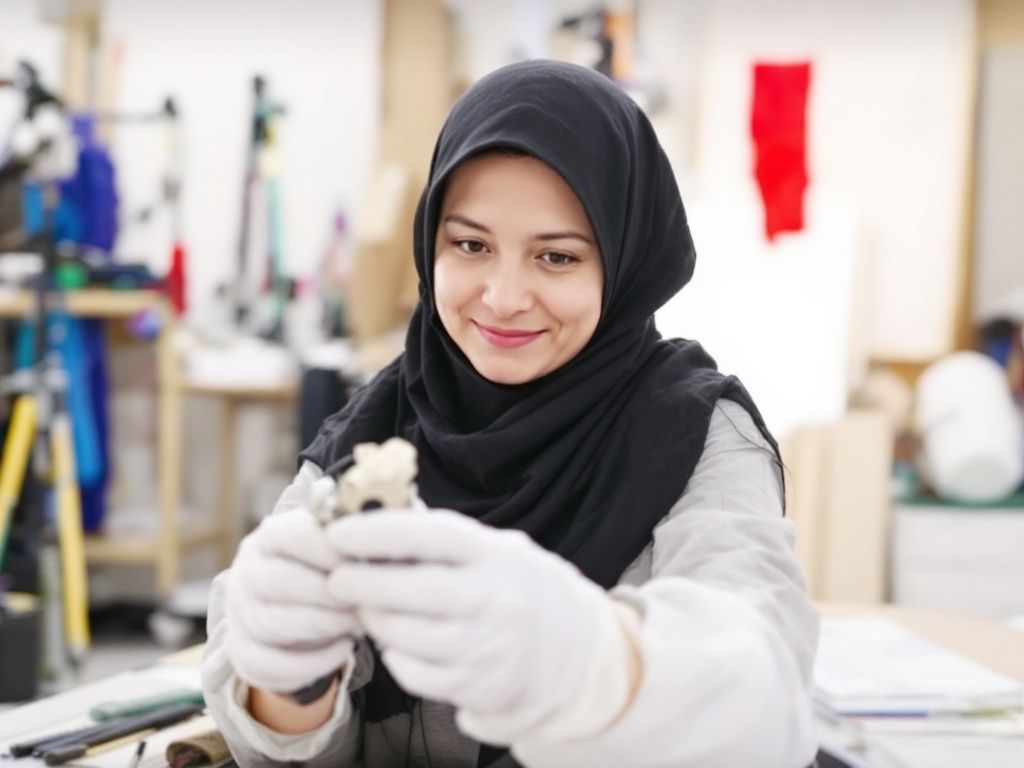Have you ever found yourself on a theater set, surrounded by all those magical props, yet constantly worried about getting that awful rash after handling certain materials? It’s a tough gig. The hustle and bustle of a props department are matched by one critical concern: how to protect your skin from the endless barrage of materials you handle every day. Whether it’s paint, glue, latex, or who knows what else, skin protection isn’t just a good idea—it’s absolutely essential.
First off, let’s set the stage. Every day, the props department is like stepping into a fantastical world where imagination becomes reality. Props breathe life into a script; they make a time period belong to the actors, a place feels lived in, and a mood comes alive. But behind every enchanted sword or delicate tiara lies a multitude of materials that demand respect and care during handling to protect one’s skin.
Understanding the Hazardous Materials
**Awareness Is Key**
Before diving deep into skin protection strategies—and trust me, we’ll get there—it’s crucial to understand the types of materials typically encountered in the props department. Come closer, imagine you’re in the workshop right now, paintbrush in one hand, bolts of fabric in the other. The variety can be overwhelming, right? Latex, plaster, bonding agents, solvents—the list goes on and on. Even supposedly harmless materials can irritate or damage your skin if handled carelessly.
Here’s a golden rule: Just assume that everything has the potential to surprise your skin, sometimes in not-so-nice ways.
**Common Culprits**
- Paints and Solvents: Essential for creating depth and realism, but many contain harsh chemicals that dry out or irritate the skin.
- Adhesives and Glues: Ah, the sticky stuff. Always seems easier to remove than it is. But mishandling these can lead to allergic reactions or burns.
- Latex and Rubber: Frequently used for replicas and molds, perfect for stage magic. Yet, latex allergies are no joke.
- Dust and Particulates: Sanding wood or sculpting clay can unleash a storm of tiny particles, which not only test your lungs but also your skin.
Alright, now that we’ve laid out our main antagonists, let’s talk about how to barricade your skin like it’s the protagonist of its own hero’s journey.

Developing a Skin Protection Strategy
The First Line of Defense: Personal Hygiene
Wash those hands like you mean it! Sounds simple, right? The effectiveness of regular and thorough hand washing can’t be overstated. Not only does it remove external irritants, but it also prevents them from making their way to more sensitive areas, like your face. Yep, we’ve all been there: an itchy nose, a tempting scratch, and BAM! Minor skin irritation turns major.
Utilizing neutral soaps with cool or lukewarm water works best. Hot water, tempting as it might be for cleanliness, can actually strip essential oils from your skin, leading to dryness and sensitivity. Over time, this can transform small irritations into persistent issues.
The Ultimate Barrier: Gloves
Let’s talk gloves. They’re like your skin’s personal bodyguard. There’s a whole world of gloves out there, crafted from materials that provide various levels of protection against specific substances.
**Types of Protective Gloves:**
- Nitrile Gloves: Resistant to solvents, oils, and some chemicals. Suitable for the majority of substance handling in props work.
- Latex Gloves: Excellent dexterity but can provoke allergic reactions, necessitating clear identification of latex-sensitive individuals in the team.
- Vinyl Gloves: Economical yet less durable than the others. These are best suited for simple cleaning tasks and short-term exposure to mild substances.
Selecting the right gloves is an art in itself. Consider the substance you’ll be handling, the duration of exposure, and whether you need precision and finesse—there’s a real Goldilocks scenario here: finding the one that’s just right.

Building an Effective Routine
**Morning Ritual**
Start each working day by checking your toolkit and making sure you have everything you need for skin protection at the ready—beyond just gloves. Think of creams, barrier sprays, and your trusty hand soap. Some mornings get chaotic, and idle preparation pays off big time late in the day.
**Throughout the Day**
Frequent breaks for handwashing, applying barrier creams, and changing gloves can’t be stressed enough. These small acts shave off the accumulation of irritants and the development of red, rashy dramas on your skin’s part.
Keep a close watch on high-touch areas like the wrist and fingers. They bear the brunt of contact and most often warrant extra love with moisturizers to prevent cracking and wounds.
**End the Day Right**
Once the day ends, head to the sink instead of rushing to the exit. A comprehensive cleansing helps reset your skin. And yeah, hydrate—skin can thank you for decades to come.
Avoiding the Common Pitfalls
We’ve discussed how to shield your skin using routines and equipment, but what about those sneaky pitfalls that appear when you least expect them? Let’s chat about avoiding these:
- Glove Wear and Tear:
- A small tear in a glove is essentially an unguarded gate. Every part of this wonderful job involves varying degrees of wear and tear. Remain vigilant and replace gloves at the first sign of distress.
- Overlying Fragrances in Products:
- Sometimes, products with overpowering fragrances can just as easily go from delightful to irritating. Fragrance often acts as an irritant, especially in open or damaged skin areas. Keep those products minimal.
- Ignoring Minor Symptoms:
- It’s tempting to power through, especially when deadlines loom large. But slight redness or an itch is often the skin whispering it needs help—heed the call! Early intervention prevents bigger issues.
Skin Protection Through the Seasons

Theater life isn’t bound by time, making it vital to adapt your protective habits to the environment. Here’s how:
- Winter: Your skin will scream for moisture.
- Summer: Work alongside sweat by choosing breathable gloves and upping hydration.
- Transitions: Watch for new irritants as seasons change—some materials become dormant or more active with different humidity and temperature levels.
The path doesn’t end there; trials and variations are more than encouraged. Your prop-handling journey isn’t just about understanding the items you create and carry but deeply knowing the material handling that adapts with your body’s all-too-humane mechanics.
A Cultural Shift: Safety and Awareness
Creating a culture of safety in the props department not only impacts personal skin protection but also the team’s morale and effectiveness.
**Share Knowledge**: Consider developing a resourceful and accessible guide/booklet per theater, making it easy to reference material-related specifics and group-shared experiences on skin safety. Not to bore you with too much structure, but sometimes the real professional journey relies on having these resources documented.
**Team Meetings and Workshops**: Periodically, holding purposeful gatherings can bridge firsthand experiences with newbies’ learns, growing the knowledge bushy and this thick, communal vigilance pays off.
Conclusions and Move Forward
There you have it, my friends. The ever-important journey to virtually pain-free epic prop building. Protecting your skin is about weaving in small, purposeful changes to your day-to-day work routine rather than waiting for an unfortunate incident to miss a call. Props oscillate between illusions and tactile realities, drawing attention to the intricate nature of its workings, as well as the unseen needs going into the tools and tricks behind the craft.
By adhering to comprehensive care and adopting rituals that suit your particular path, your skin, and overall well-being are very much connected. It’s a profession that commands quick thinking but also guides intuitive, protective foresight —a community bound by its prop magic.
Welcome to a safer, more aware skin suite of armor, as you greet the theater’s future bric-a-brac adventures without hesitating. Take care, and may each prop find you, with soft, confident hands proving that indeed, skin protection is an art well worth mastering.
Frequently Asked Questions About Skin Protection
How Do I Determine My Skin Type for Effective Skin Protection?
Determining your skin type is crucial for effective skin protection. The most common skin types are oily, dry, and combination skin. Oily skin is often shiny and can be caused by stress, humidity, genetics, or hormones. Dry skin is typically weather-induced and may appear red or flushed. Combination skin is a mix of both oily and dry skin. Knowing your skin type helps you choose the right products and treatments[1][5).
What Skincare Routine Should I Follow for My Skin Type to Ensure Proper Skin Protection?
The skincare routine varies based on your skin type. For oily skin, use an oil-free and non-comedogenic cleanser, moisturize daily, and apply sunscreen. For dry skin, use a cleanser with hyaluronic acid, an alcohol-free toner, and a moisturizer to maintain hydration. For combination skin, balance products to address both oily and dry areas[1][5).
How Often Should I Apply Sunscreen for Adequate Skin Protection?
Sunscreen should be applied every two hours, and more frequently if you have been swimming, sweating heavily, or drying off with a towel. Choose a broad-spectrum sunscreen with an SPF of at least 30 for daily activities and SPF 50 or higher for intense sun exposure. Apply sunscreen even on cloudy days as UV rays can penetrate through clouds[3).
What Are the Best Practices to Protect My Skin from Acne and Other Common Skin Imperfections?
To protect your skin from acne, use products containing benzoyl peroxide and salicylic acid. For eczema, bathe in lukewarm water with a mild cleanser, wear soft clothing, and use moisturizers to keep the skin hydrated. Topical treatments and steroids may be necessary in severe cases. Maintaining a consistent skincare routine and avoiding irritants can help prevent breakouts and other skin issues[1][5).
References










